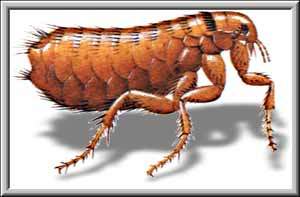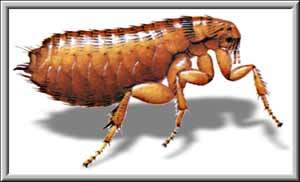
Ceratophyllus
gallinae
(The Bird Flea)
(The Bird Flea)

Dasypsyllus
gallinulae
(The Bird Flea)
(The Bird Flea)
This type of flea spend the winter in their pupal cocoons in birds' nests. They emerge in the warmth of the spring sun..(where do they live..?..Florida..) anyway, if they do not quickly find a bird to suck blood from, they start to move about. In such circumstances they may well enter houses, but one may also acquire them when gardening in the vicinity of infected nesting boxes or nests. Bird fleas can, of course, multiply enormously in hen houses, breeders, batteries etc. Fortunately, bird fleas only live for a short time indoors, and they can only breed in birds nests. It is a good idea to clean out nesting boxes very thoroughly in the early spring. Ceratophyllus above is the most common bird flea in Britain, being abundant in poultry houses and "Tit" nesting boxes. Dasypsyllus is mostly found on small bird species.C. gallinae spends little time on the host but rather settles itself in the nesting material. It breeds during the bird nesting period when the host and the young are available for regular blood meals. The larvae develop in the nesting material and feed on detritus and undigested blood excreted by the parents. Higher temperatures will speed up the development time, which has been shown by many experiments (Cotton 1970) for one. Theories have it that the adult fleas produce a new adult generation during one reproductive cycle of the bird. It is known that adult fleas leave the nest soon after the young birds have fledge, with some being carried away on the young birds themselves. The flea larvae which remain in the nest complete their cycle and reach adult size. Most of the imagos (an insect in its sexually mature adult stage after metamorphosis) remain quiescent until the following spring. Emergence from the cocoon being triggered by, amongst other things, the rising temperatures.
Reference: Cotton M. J. 1970; The Life History of the Hen Flea Ceratophyllus gallinae (Shrank) (Siphonoptera ceratophyllidae). Entomologist 103: 45-48